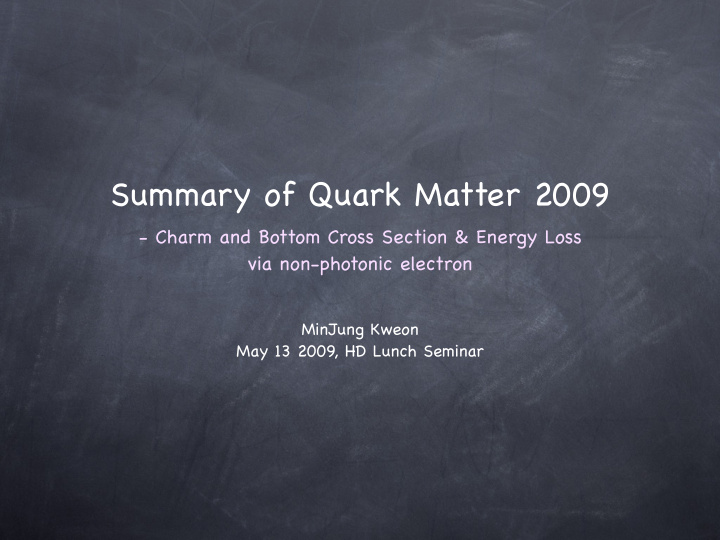



Summary of Quark Matter 2009 - Charm and Bottom Cross Section & Energy Loss via non-photonic electron MinJung Kweon May 13 2009, HD Lunch Seminar
Heavy Quark Energy Loss at RHIC Vitev, I .et. Al J. Phys. G Nucl. Part. Phys. 34 Garcia-Martinez, et.al.arXiv:hep-ph/0702035v2 2007 Resonance Mode + Expanding Fireball Relativistic Langevin simulation in thermal fireball background Van Hees,Greco + PR ʻ 05 2 Wiedemann et al. ʼ 05, Wicks et al. ʼ 06, Vitev et al. ʼ 06, Ko et al. ʻ 06
Charm/Bottom Separation Using e-h Correlations Tatia Engelmore For the PHENIX Collaboration Quark Matter 2009 (arXiv:0903.4851 hep-ex)
Charm to Bottom Ratio Charm-to-bottom ratio in p+p (left). Comparison of charm and bottom cross sections in p+p (right). Spectrum is extrapolated to p T = 0 using the shape predicted by pQCD calculation d σ bb /dy| y=0 = 0.92 μ b, using HVQMNR PDF : σ bb = 3.2 μ b PHENIX result from the dielectron spectrum: σ bb = 3.9 μ b FONNL: σ bb = 1.87 μ b (here, didn ʼ t write down the error bar. agree within error bar) 4
Method to get (b → e)/(c → e + b → e) [1] Partial reconstruction of D/D → e ± K ∓ X near side e-h Construct unlike charge-sign near-side electron- hadron pairs Calculate e-K invariant mass, below the D meson mass of ~ 1.9 GeV/c, it reveals a correlated signal of D away side e- µ Inclusive reconstructed e-h pairs are: Δ N pair / Δ M eK Unlike-sign pairs from charm Unlike-sign pairs from beauty Combinatoric background where the electron is a background electrons → main BG sources mostly from conversion electrons M eK Background from unlike-sign h-h pairs due to hadron contamination 5
Method to get (b → e)/(c → e + b → e) [2] Subtract like-sign pairs to remove background Calculate # of BG subtracted unlike-sign e-h pairs for invariant mass within 0.4 < M eK < 1.9 GeV/c # of measured heavy flavor electrons Use Pythia to find charm and bottom tagging efficiencies. Combine efficiencies to get charm to bottom ratio. (b → e)/(c → e + b → e) 0.26 at 3 < p T < 4 GeV/c 0.63 at 4 < p T < 5 GeV/c 6
Non-Photonic Electron-Hadron Azimuthal Correlation for Au+Au, Cu+Cu and p+p collisions at √ s= 200 GeV Bertrand Biritz For the STAR Collaboration Quark Matter 2009 (arXiv:hep-ph/0602067)
Non-photonic e-h correlations in p+p 200 GeV Clear azim. correlation is observed around near and away side Fitting measured dn/d φ distribution for B and D decays, we can estimate B decay contribution to non-photonic electron. B D Δ φ e − h = r + (1 − r B ) Δ φ e − h B Δ φ e − h r B = e B /( e D + e B ) X.Y. Lin, hep-ph/0602067 AA + e C AA e B R AA = pp + e C pp ) N bin ( e B AA pp e B e B = pp ⋅ pp + e C pp ) N bin e B ( e B AA pp e C e C + pp ⋅ pp + e C pp ) N bin e C ( e B e b + (1 − r e c = r B R AA B ) R AA pp /( e B pp + e C pp ) r B = e B 8
R e(c)AA and R e(b)AA Correlation p T > 5 GeV/c R e(c)AA and R e(b)AA correlation together with models R e(b)AA < 1 ; B meson is also suppressed prefer Dissociate (II) and Resonance (III) model(large b energy loss) I: Djordjevic, Gyulassy, Vogt and Wicks, Phys. Lett. B 632 (2006) 81; dN g /dy = 1000 II: Adil and Vitev, Phys. Lett. B 649 (2007) 139 III: Hees, Mannarelli, Greco and Rapp , Phys. Rev. Lett. 100 (2008) 192301 Comparable B and D contributions for electron pT from 5.5 ~ 9 GeV/c FONNL prediction and the e B /(e B +e D ) results are consistent with each other within errors 9
Recommend
More recommend